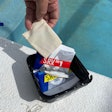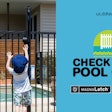Growing up around the grocery industry, I quickly learned the importance of things like store layout and flow, merchandising strategies, product mix and selection and creating in-store theatrics. All of these things are extremely important in a successful retail selling environment, but there was always one topic that I found more interesting than the others: how to create a pricing strategy that can influence what a customer buys. This is called "the psychology of pricing." Many things go into the psychology, and it all starts with understanding how our brain rationalizes the decision to purchase something.
To start, we have to go back to the caveman days. Back in those primitive years, we were hunters and gatherers whose survival depended on acquiring and accumulating basic resources such as food, water and shelter.
As we evolved, we started trading and began using a monetary system. But when you think about it, spending money is just another means of acquiring those basic essentials for survival, just like hunting and gathering.
Here's where it gets interesting — our brain doesn't recognize the difference. Our brain rationalizes spending money by using the same primitive part of the brain as the hunters and gatherers did. So in essence, spending money is experienced in the same part of the brain as feeling physical pain! Men were also traditionally the hunters, which explains why we hate shopping.
The first lesson you as a business owner need to understand is that not every consumer is rational when it comes to pricing. And I am going to show you an example on how that lack of rationality can make a huge impact on sales:
What to Eliminate
Researchers at Cornell University created an experiment at St. Andrew's Café, part of the Culinary Institute of America in Hyde Park, New York. They offered three types of menus:
1. One had the price listed with a dollar sign in front of the numerals.
2. One listed the price without a dollar sign.
3. The third had the price followed by the word "dollar," fully spelled out.
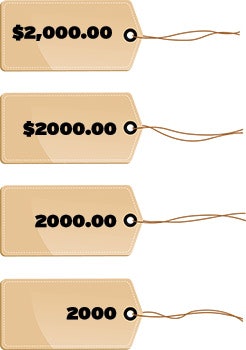 Removing punctuation and extra zeroes lessens the pain response your customer feels about the price by making the product seem less expensive. As a result, your customer is more comfortable making a purchase.
Removing punctuation and extra zeroes lessens the pain response your customer feels about the price by making the product seem less expensive. As a result, your customer is more comfortable making a purchase.
The results were interesting — when prices were listed with a dollar sign ($5.00), customers spent less. And when the dollar sign was absent (5.00), they tended to spend more. Even spelling out the word "dollar" triggered what is called a "pain of paying response."
Removing the currency symbol ($) lessons the pain associated with the number, which is why you often see restaurants omitting the currency symbol from their menus.
When merchandising new products in your store, try removing all the dollar signs you can. If you can't, try making it as small as possible to reduce the pain of paying response.
While you're at it, you might want to consider removing punctuation (decimal points and commas in particular) and excessive zeros. To see why, take a look at the below numbers — which looks the most expensive?
The first two both look and feel more expensive. Trimming the punctuation and extra zeroes can make customers more comfortable with the price and product.
Left Digit Effect
Many of you might already use a charm pricing strategy in your store, but do you know how it works?
Charm pricing is the term for items that end in 99 or 95. It works because the leftmost digit disproportionately affects our perception of price. You see, our brains encode numbers so quickly (and beyond consciousness) that we encode the size of a number before we finish reading it.
For example, the "2" in $2.99 exerts more influence on our perception of price than the "99." So shaving the price of something is most effective when it changes the leftmost digit (in this case from a 3 to a 2). The psychological difference between a $5.99 leaf net and a $6.00 leaf net is bigger than the difference between $5.60 and $5.59 because the leftmost digit matters most.
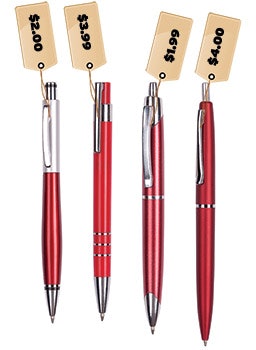 The pen study by Kenneth C. Manning and David E. Sprott revealed the science behind charm pricing.
The pen study by Kenneth C. Manning and David E. Sprott revealed the science behind charm pricing.
To prove this, a study was done by Kenneth C. Manning and David E. Sprott titled "Price Endings, Left-Digit Effects, and Choice." (Journal of Consumer Research, August 2009). In the study, Manning and Sprott asked participants to consider two pens, one priced at $2.00 and the other at $4.00. A penny decrease in the price of either pen lowered the price's leftmost digit. (See Fig. 1.)
The researcher manipulated the prices and found that when the pens were priced $2.00 and $3.99, 44 percent of the participants selected the higher-priced pen.
But when the pens were priced $1.99 and $4.00, only 18 percent of the participants chose the higher-priced pen.
The larger perceived price difference between the pens priced at $1.99 and $4.00 led people to focus on how much they were spending and ultimately resulted in a strong tendency to select the cheaper alternative.
So anytime you can reduce the left digit by reducing the right digit by one, do so! Your sales will thank you!
More or Less Syllables?
So do you think a price seems more expensive if it has more syllables? All the research including says it does. When you read a price in written form, your brain subconsciously encodes the auditory version of that price (Dehaene, 1992):
$27.82 (7 Syllables)
$28.16 (5 Syllables)
When we read a price tag, our brain immediately encodes the value and determines the price with more syllables seems more expensive.
So keep in mind the syllable count when you are setting pricing of anything in your store. Even syllable counts on the small stuff can make a big difference!
Price Position and Size
Consistency in retail is an absolute must. And it becomes exceptionally important when you have multiple locations to contend with. But can the position of a price on a sign and its font size really affect the way our brain encodes the number?
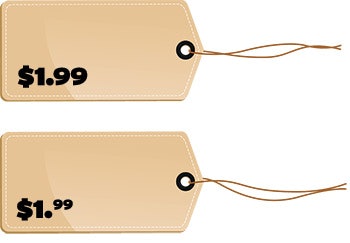 The bottom price tag feels less expensive to your customers because of the small font size for the 99 cents.
The bottom price tag feels less expensive to your customers because of the small font size for the 99 cents.
Absolutely. We as consumers are trained to shop by every store we visit, from grocery stores and mass merchants to specialty retailers like pool and spa stores. We've been trained to know that items placed higher on a shelf are more expensive — that's why some alcohol is described as "top shelf." Our brain understands this, and when we see a price at the top of a sign first, our brain perceives it as a more expensive item even though it might not be.
The solution is to not only put the price at the bottom of the sign, but also make the font as small as possible and tuck it into either the left or right side of the sign. This makes the price seem small and insignificant and thus lower.
Consider reducing the size of the font on right hand digits as well. Which one seems lower priced to you?
Ahh, the psychology of pricing at its finest.
Value
I cannot preach the meaning of value enough, and I think many of the stores I visit truly don't understand how creating value has an even bigger impact in a referral-based business than it does during the initial purchase. You see, our goal is to turn consumers from "bargain hunters" into "value seekers." We all love a bargain, but value trumps bargain almost 100 percent of the time.
I love to tell the story of how my wife went out and bought a convection microwave to replace the ailing unit in our kitchen. You see, my wife is a real bargain hunter. She will research something to the nth degree and then try to stack coupons, in store deals and such before she makes a purchase. So she went into our local retail store to buy the product she researched, armed with her coupons — and that's when the salesperson threw her for a loop. He pointed out that my wife could have a premium name-brand appliance for just $100 more. He showed her a limited time in-store special that was reduced from $1999.99 to $999, and then she could use her coupon and it would only be $499. I still remember the day when she entered the house and told me the whole story in grave detail. Then she told every person who came to our house. I have heard her tell that story again and again and again. That salesperson turned my wife from a Bargain Hunter to a Value Seeker. He created value — whether the price was a deal or not, she was sold on the value. And all of our friends have been referred to that retailer because of it.
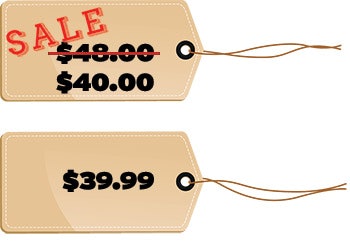 A study found that customers presented with the above two pricing options overwhelmingly purchased the $40.00 item due to its perceived quality and value.
A study found that customers presented with the above two pricing options overwhelmingly purchased the $40.00 item due to its perceived quality and value.
Economist Richard Thaler from the University of Chicago even did a value experiment. He priced two identical items in a different way. The first was labeled on sale for $40, regularly $48. The second item was simply charm priced at $39. (See Fig 2.)
Consumers overwhelmingly purchased the $40 item — even though there was a less expensive option — because it was perceived as higher quality and a better value even though they were identical!
Finally, you can sell value by "price anchoring" an item, or by placing ultra-premium products and services near more standard options. This creates a clearer sense of value for potential customers, who will view the less expensive options as a bargain in comparison.
In other words, the best way to sell an $8,000 hot tub is to set it next to a $30,000 swim spa.
Decoy Effect
The decoy effect (or the asymmetric dominance effect) is one of the most classic pricing strategies you'll find. In short, it's a way to influence a customer's purchasing decision by adding a third option to the mix. Apple is a master at it — if you've ever bought an iPhone or an iPad, you're familiar with the decoy effect. Here's how it works:
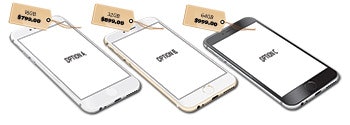 A close look at the decoy effect. Which phone would you choose? - Click to enlarge
A close look at the decoy effect. Which phone would you choose? - Click to enlarge
When you're thinking about buying a new iPhone, you're generally debating the price versus the storage capacity. It's one thing when you're choosing between two items, but Apple offers three storage sizes, each at a different rate. (See Fig. 3.)
Option A might not have enough space for you. Option B seems like a good fit, but then you look at the price tags. This is when your brain starts to rationalize buying the top-tier model. While it's the most expensive, you can get twice the storage for just $100 more. What a deal!
That's the power of the decoy effect: It increases customer preference for the dominating option (in this case, the top-tier Apple model) and pushes you to buy the product they really want to sell.
I've used this strategy before with aboveground pools. Say you're walking a customer through a few pool options. You explain resin and steel and the advantages of each — and then you introduce them to the resin/steel hybrid. I priced the hybrid model the same as the aluminum model, and as a result, we saw more hybrid model sales.
These are just a few of the many ways the psychology of pricing can help you sell more without selling more. So during downtime or the off-season, take some time to think about your pricing and product selection and analyze what is and is not selling. Quite often, you can trace a product's success to how it was priced in comparison to other products in the store or if you are, in fact, creating value for the customer.
Ted Lawrence has been in the specialty swimming pool industry for more than 24 years and is known as a leading authority on omnichannel retail. With his experience and proven methods, Lawrence coaches hundreds of small independent as well as large multi-store chains on how to skyrocket revenues, increase consumer loyalty, plan for the future and reach the next level. He is an award-winning international presenter at dozens of industry events globally.
Comments or thoughts on this article? Please e-mail [email protected].


























